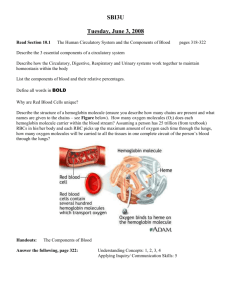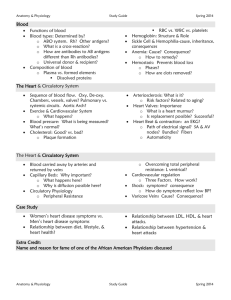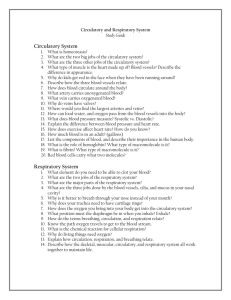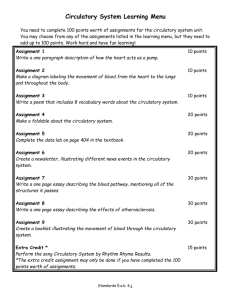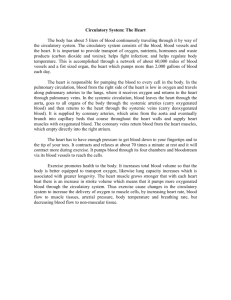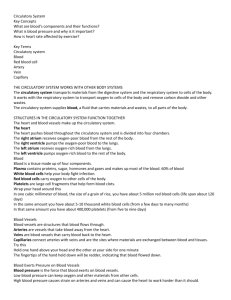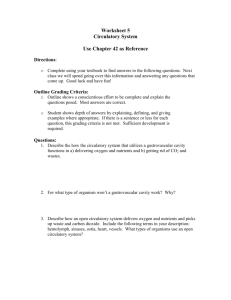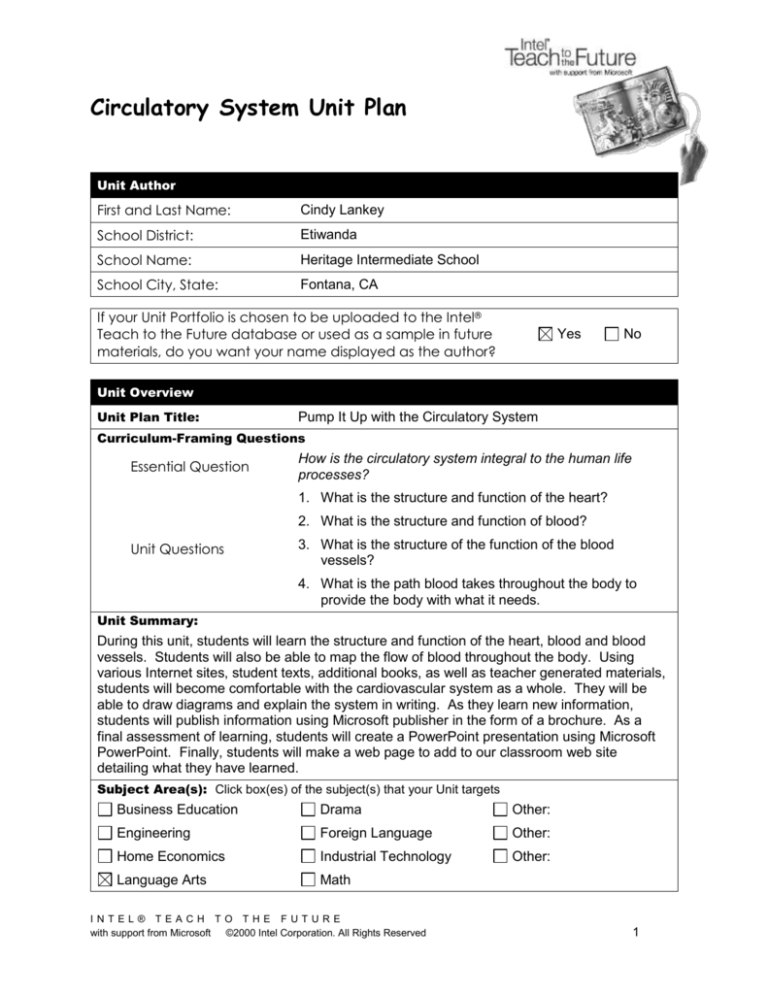
Circulatory System Unit Plan
Unit Author
First and Last Name:
Cindy Lankey
School District:
Etiwanda
School Name:
Heritage Intermediate School
School City, State:
Fontana, CA
If your Unit Portfolio is chosen to be uploaded to the Intel®
Teach to the Future database or used as a sample in future
materials, do you want your name displayed as the author?
Yes
No
Unit Overview
Unit Plan Title:
Pump It Up with the Circulatory System
Curriculum-Framing Questions
Essential Question
How is the circulatory system integral to the human life
processes?
1. What is the structure and function of the heart?
2. What is the structure and function of blood?
Unit Questions
3. What is the structure of the function of the blood
vessels?
4. What is the path blood takes throughout the body to
provide the body with what it needs.
Unit Summary:
During this unit, students will learn the structure and function of the heart, blood and blood
vessels. Students will also be able to map the flow of blood throughout the body. Using
various Internet sites, student texts, additional books, as well as teacher generated materials,
students will become comfortable with the cardiovascular system as a whole. They will be
able to draw diagrams and explain the system in writing. As they learn new information,
students will publish information using Microsoft publisher in the form of a brochure. As a
final assessment of learning, students will create a PowerPoint presentation using Microsoft
PowerPoint. Finally, students will make a web page to add to our classroom web site
detailing what they have learned.
Subject Area(s): Click box(es) of the subject(s) that your Unit targets
Business Education
Drama
Other:
Engineering
Foreign Language
Other:
Home Economics
Industrial Technology
Other:
Language Arts
Math
INTEL® TEACH TO THE FUTURE
with support from Microsoft ©2000 Intel Corporation. All Rights Reserved
1
Music
Physical Education
School to Career
Science
Social Studies
Technology
Grade Level: Click box(es) of the grade level(s) that your Unit targets
K-2
3-5
6-8
9-12
ESL
Resource
Gifted and Talented
Other:
INTEL® TEACH TO THE FUTURE
with support from Microsoft ©2000 Intel Corporation. All Rights Reserved
2
Targeted State Frameworks/Content Standards/Benchmarks:
Structure and Function in Living Systems
The anatomy and physiology of plants and animals illustrate the complementary nature of
structure and function. As a basis for understanding this concept:
a. Students know plants and animals have levels of organization for structure and function,
including cells, tissues, organs, organ systems, and the whole organism.
b. Students know organ systems function because of the contributions of individual organs,
tissues, and cells. The failure of any part can affect the entire system.
Student Objectives/Learning Outcomes:
1. The learner will investigate the cardiovascular system to find out how it is organized.
2. The learner will draw diagrams of the various parts of the cardiovascular system to show
the structure.
3. The learner will map the flow of blood through the body using a picture of the body with
the heart and blood vessels showing. Arrows and different colors can be used to map the
flow.
4. The learner will write mini reports on the function of the heart, blood, and circulatory
systems.
5. The learner will show the relationship between the various cells, tissues, and organs of
the circulatory system by creating a flow chart.
Procedures:
1. Students will work in pairs to investigate various web sites on the cardiovascular system
as an introduction. Their goal would be to list the parts of the system, the function and
purpose as they look at each site. Students would then share what they have found.
2. The teacher will give detailed notes on structure and function of the heart. Students would
label the various parts of the heart diagram as the teacher discusses each part. The
students would then read p. 492-500 in their science texts.
3. Together the class will discuss various heart vocabularies. The teacher will then
demonstrate a heart dissection so those students can see the inside of a heart.
4. Students will complete a lab activity (Heart as a Pump) to investigate how the heart
pumps. They will learn about pulse.
5. The teacher will give detailed notes on the structure and function of blood. They will
diagram the parts with an emphasis on new vocabulary. The students will then read p.
502-508.
6. Students will use beads, sequins, etc. to create a model of blood substances.
7. The teacher will give detailed notes on the different kinds of blood vessels. The students
would then have a scavenger hunt in order to find something that would represent the size
of the various vessels.
8. The teacher will give notes on the 3 parts of the circulatory system. Students will diagram
the flow of blood on a worksheet with the outline of the body and the sections of the
circulatory system.
INTEL® TEACH TO THE FUTURE
with support from Microsoft ©2000 Intel Corporation. All Rights Reserved
3
9. The students will complete a circulation wheel showing how the blood circulates through
the body.
10. After each component is introduced to the students, they will go to the computer lab in
order to update their brochure using Microsoft Publisher.
11. Students will create a PowerPoint presentation using the outline form first.
12. Students will create a web page using predetermined plan.
Approximate Time Needed:
15-20 days of instructions, 50 minutes
Prerequisite Skills:
Students would need organization and research skills. The technological skills can be taught
as needed.
Materials and Resources Required For Unit
Technology – Hardware: (Click boxes of all equipment needed)
Camera
Laser Disk
VCR
Computer(s)
Printer
Video Camera
Digital Camera
Projection System
Video Conferencing Equip.
DVD Player
Scanner
Other:
Internet Connection
Television
Technology – Software: (Click boxes of all software needed.)
Database/Spreadsheet
Image Processing
Web Page Development
Desktop Publishing
Internet Web Browser
Word Processing
E-mail Software
Multimedia
Other:
Encyclopedia on CD-ROM
Printed Materials:
Glencoe, Science Voyages, Life Science: 2001.
World Book Encyclopedia 2001
Bill Nye Video: Circulation
Supplies:
Arts and Crafts
Various Handouts
INTEL® TEACH TO THE FUTURE
with support from Microsoft ©2000 Intel Corporation. All Rights Reserved
4
Pathfinders for Kids: The Circulatory System
http://infozone.imcpl.org/kids_circ.htm
Pictures, kid friendly information
The Circle of Blood
http://sin.fi.edu/biosci/systems/circulation.html
Overview of the system, pictures, basic information
Cardiovascular Pathology Index
http://www.medlib.med.utah.edu/WebPath/CVHTML/CVIDX
Tutorials, great photos!
Cardiovascular System
http://yucky.kids.discovery.com/noflash/body/pg000131.html
Pictures and kid friendly facts
My Body
http://www.ashland.k12.or.us/morgan_cottle/body/body.htm
Kid reports on the human body systems with pictures
Map of the Human Heart
http://www.ashland.k12.or.us/morgan_cottle/body/body.htm
Detailed map of how blood circulates through the heart, kid
friendly
Lifeblood
http://sln.fi.edu/biosci/blood/blood.html
Shows pictures of the various substances in blood with facts
Internet Resources:
The Circle of Blood
http://sln.fi.edu//biosci/systems/circulation.html
Information on how blood circulates
The Circulatory System
http://www4.tpgi.com.au/users/amcgann/body/circulatory.ht
ml
General information
Hillendale Health
http://hes.ucf.k12.pa.us/gclaypo/circulatorysys.html#The%20
Heart
Circulatory system facts
Your Gross and Cool Body
http://yucky.kids.discovery.com/flash/body/
Intriguing information for kids
Top Education
http://www.top-education.com/HumanBody/index22.htm
Body systems information
California State Standards
Page 5 of 6
Others:
Doctors
American Red Cross
Accommodations for Differentiated Instruction
Resource Student:
These students would be partnered with other students. They
would be given specific jobs to complete towards each
project. Various research guides would be given to help with
organizing research and facts. Additional time may be
necessary in addition to requirement modifications.
Non-Native English
Speaker:
Students would be directed to Internet sites in their given
language. They would be partnered with other students for
additional help. Many of the same expectations for resource
students would apply to the non-native English speakers.
Gifted Student:
Students could do additional research on blood-related
diseases, heart disease, or heart transplants, etc. Students
may work on additional presentations. They may also apply
what they have learned to other body systems and make
comparisons and generalizations.
Student Assessment:
Students will be assessed throughout the unit. Journals,
essays, quizzes, tests, and final products will be graded to
determine student learning. Teacher observations will be
made throughout the unit and noted for assessment purposes.
Key Word Search:
Cardiovascular system, circulatory system, heart, blood, blood
vessels, and pulse
Page 6 of 6


